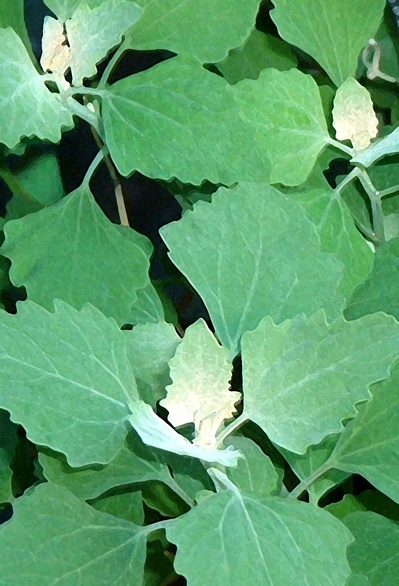Wildcrafting: the humble plant called lamb’s quarters and goosefoot

Lamb's quarters are a great nutritional weed and taste good, too.
Linda Diane Feldt | Contributor
- easy to find and identify
- packed with calcium - a vital nutrient, removed by many gardeners who then plant an inferior plant nutritionally speaking (lettuce)
- great tasting
- can be used in many ways (raw as a salad base, a green in sandwiches, cooked in casseroles and soups, as a pot green alone or with other greens
- easy to encourage to grow
I also remember being “caught” by a fellow herbalist about 30 years ago pulling it from my garden. I was humbled, I had no idea I was destroying such a valuable plant due to plain ignorance. I want to remember that naïve moment and have compassion for people just learning about wild foods.
Lamb’s quarters can be 1-4 feet tall this time of year, depending on location. The leaves are used as food, especially the new shoots. Both raw and cooked they are tasty on their own or mixed with other greens. The tiny black seeds can also be painstakingly harvested, winnowed and cooked as a grain or ground for flour. You can also use the seeds whole in breads and other baked products.
Almost all the calcium-rich greens also contain oxalic acid. I’ve been asked many times if greens are actually dangerous or might cause kidney stones if they are high in this ingredient.
The answer appears to be no. Recent information literally ties calcium consumption to oxalic acid - when they are both present they bind together and the oxalic acid is removed from the intestines. If calcium is not present, then the acid may pass into the kidneys and you may be at greater risk of stone formation.
I’m not convinced that we have all of the answers yet, but certainly dark green leafy vegetables have done well delivering calcium safely to consumers for as long as we know. And lamb’s quarters is a champion when it comes to calcium. It even has a chalky appearance, and a chalky taste - many plants high in calcium has this familiar mineral-like chalky flavor.
Pick the tender leaves, especially early in the spring. But even once the plant is four feet tall or more, the new leaves can be eaten as is. The older leaves are better cooked. You can also harvest the leaves now to eat this winter. Simply dunk them for a few seconds in boiling water, then place in a freezer container. They are then great in soups, casseroles, with rice, and so many other ways later on.
I end up with a lot of frozen but already mostly cooked vegetables in my freezer. The easiest way I’ve found to eat them is to use my rice cooker. I add rice and water as normal, and just place the frozen veggies on top. By the time the rice is done, the veggies are thawed and also cooked. A very quick and easy meal.
You’ll find lamb’s quarters in disturbed ground, most often already happy in your garden. It is one of the first delicate greens to emerge in the spring, a lovely patch of double-leaved seedlings ready to be thinned by eating.
Linda Diane Feldt is a local Holistic Health Practitioner, writer, and teacher. She offers a free herb class through the People’s Food Co-op which will return again the end of September. You can follow her on Twitter, visit her web site or e-mail her directly ldfeldt (at) holisticwisdom.org Her cookbook, "Spinach and Beyond: Loving Life and Dark Green Leafy Vegetables" featuring lamb’s quarters on the cover, is available locally at Nicola’s Books, Morgan and York, Crazy Wisdom Bookstore and also through Amazon.com


Comments
Rork Kuick
Thu, Jul 29, 2010 : 7:24 a.m.
Yeah, folks aren't just trying to be cool when they give the scientific names. For me, talking about mushrooms or insects without them can be even more frustrating than herbs. Some worst cases are "fish fly", "stump mushroom", "black fly", where sometimes I'm not even sure what taxonomic Order is being talked about until we play 20-questions ("did it have gills?").
Linda Diane Feldt
Wed, Jul 28, 2010 : 4:54 p.m.
I make a point of using the Latin name at least once in all of my blogs, usually when first mentioning the plant. If you ever find me not doing that it is an error. Posting by Twitter is challenging. By the time I've used the Latin, I don't have much room to say the rest. This has always bothered me. I should ask my followers, should I post a second tweet each time giving the Latin name, or let it go and trust people know? I'm leaning to the first option - the more precise the information the better when talking about eating wild plants.
Linda Diane Feldt
Wed, Jul 28, 2010 : 4:49 p.m.
Ed it is true, some also call Lamb's quarters pigweed. I always called Amaranth pigweed - it has the tell tale red just showing above the dirt and a more pronounced red in the stalk. That weed is best cooked, the leaves don't taste like much raw. But it as a similar seed to chenopodium that can also be used for flour or added to baked goods whole And is also painstaking to harvest.